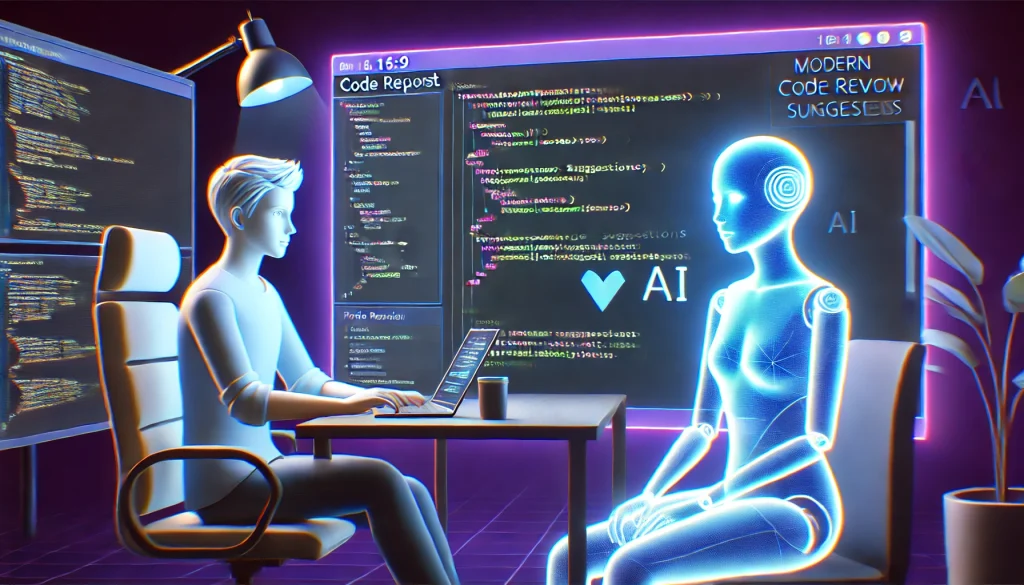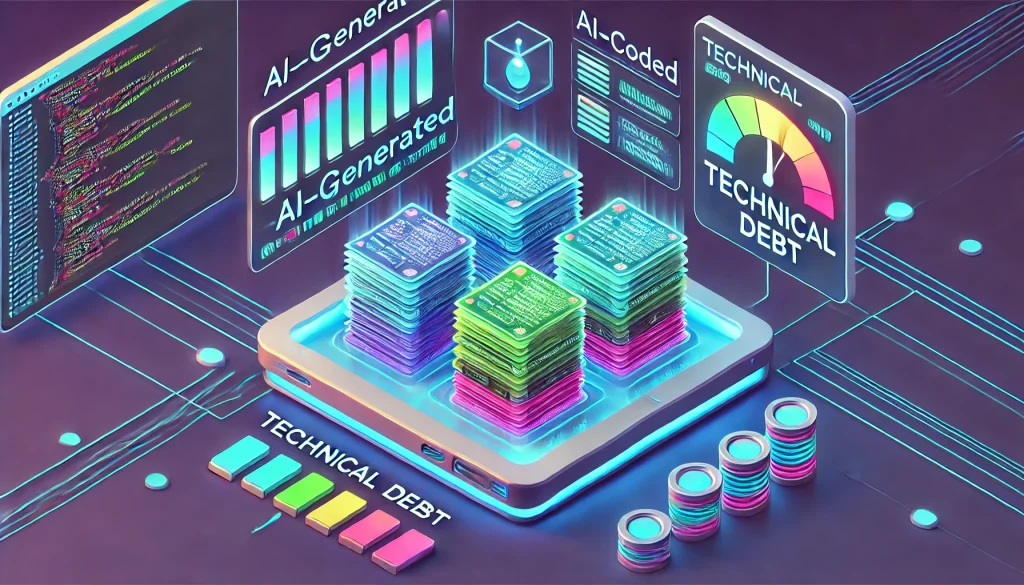With AI-driven code generation reshaping software development, the code review process is evolving. Tools like GitHub Copilot, Tabnine, and custom LLMs now generate entire code snippets, classes, or even entire modules. While this speeds up development, it also introduces new challenges—from verifying correctness to spotting potential vulnerabilities. Below, we’ll examine how AI influences code reviews, best practices for ensuring security and quality, plus expert opinions on taming technical debt in partially AI-driven codebases.

1. AI’s Role in Modern Code Generation
1.1 Speed and Efficiency
- Boilerplate Elimination: AI suggestions remove repetitive tasks, letting devs focus on architecture or logic.
- Prototype Rapidly: Entire classes or functions appear from brief prompts, accelerating feature development.
- Refactoring Hints: Some AI tools suggest improvements—like variable renames or micro-optimizations—during code completion.
1.2 Growing Complexity
- Multiple Sources: Hybrid code may blend human-written logic, AI-suggested snippets, and older in-house libraries.
- Niche Domain Gaps: AI might produce generic solutions not tailored to advanced business rules, leading to hidden mismatches or incomplete compliance.
Outcome: Devs must carefully verify each AI-suggested block for correctness, style, and performance—even as AI addresses the menial side of coding.
2. Why Code Review Still Matters
2.1 Human Judgment for Edge Cases
- Semantic Understanding: AI can’t always interpret domain-specific constraints or nuanced business logic. Humans can catch these misses.
- Readability & Maintainability: Code that “works” might be unreadable or lack consistent style. Reviewers ensure it’s maintainable for future devs.
2.2 Security & Licensing Issues
- Potential Vulnerabilities: AI suggestions might contain insecure patterns (e.g., missing input sanitization, outdated encryption).
- Code Snippet Licensing: Some AI-based code completions risk licensing concerns if they directly replicate open-source code under certain terms. Human reviewers can spot suspicious blocks.
Key: Even advanced AI code generation doesn’t replace the human capacity to interpret context, watch out for domain requirements, or preserve project style guidelines.
3. Best Practices for Reviewing AI-Generated Code
3.1 Use Automated Tools First (Linters, Static Analysis)
- Linting: ESLint, Pylint, or language-specific linters can highlight obvious syntax or style issues.
- Static Analysis: Tools like SonarQube, Snyk Code, or local analyzers catch security flaws or code smells.
- Automated Tests: If you have a robust test suite, run new AI-suggested code to see if it breaks existing constraints.
Why: Start with a baseline. If basic checks fail, no sense in deeper manual review.
3.2 Validate Domain Logic & Requirements
- Context Checking: AI suggestions might only partially match your feature’s domain logic. Cross-check with user stories or acceptance criteria.
- Design Consistency: Confirm if the code aligns with your project’s architecture patterns (DDD, layered architecture, event-driven, etc.).
- Scalability: Evaluate data structures or concurrency approaches. AI might choose suboptimal solutions for large-scale usage.
Tip: AI can produce code that compiles but misrepresents business rules. Domain experts must confirm correctness.
3.3 Security & Privacy Checks
- API / Input Validation: Ensure no injection vulnerabilities or missing token checks.
- Credential Management: AI-suggested logic must not accidentally log sensitive data or create plain-text secrets.
- Data Flow: If personal data is handled, confirm compliance with relevant guidelines (GDPR, HIPAA, etc.).
Caution: The code might appear correct but skip vital security patterns. Reviewers add the final layer of defense.
3.4 Style & Consistency
- Project Standards: Does the code follow naming conventions, indentation, and standard library usage?
- Refactor / Simplify: AI suggestions can be verbose or “kitchen sink”–like, needing a second pass to streamline.
- Docstrings / Comments: Encourage or add docstrings to clarify newly introduced logic or references.
Outcome: Clean, consistent code fosters easier maintenance—AI might not always produce the neatest patterns.
3.5 Tag Potentially AI-Generated Blocks
- Comment or Git Annotations: Some teams label “AI-suggested” code lines so future devs know to re-check if issues arise.
- Version Control: Tools might track code suggestions from AI vs. manual dev edits, offering a paper trail for any licensing or bug queries.
Benefit: Transparent tracking helps debug if certain AI blocks keep causing repeated issues or licensing concerns.
4. Managing Technical Debt in Hybrid Codebases
4.1 The ‘Partial AI’ Pitfall
- Random Patterns: AI suggestions might diverge from established project design or create half-baked solutions.
- Inconsistent Abstractions: Repeated AI suggestions can produce near-duplicate classes or mismatch existing patterns.
4.2 Expert Tips
- Periodic Refactoring: Schedule sprints or short cycles to unify code styles, remove duplicates, and standardize patterns introduced by AI.
- Architecture Consistency: Keep an “architecture guardians” group or code owners who watch for domain misalignments or puzzling structures.
- Documentation: Encourage thorough doc updates or inline comments, describing the rationale behind AI-suggested segments.
4.3 Real-World Example
A dev team might adopt GitHub Copilot for new endpoints. Over months, the codebase accumulates “AI style” methods that are verbose or deviate from the project’s domain layering. The architecture lead organizes a “refactor day” each quarter to unify naming, ensure domain boundaries remain consistent, and tackle any “spaghetti code” from unverified AI blocks.
5. Future Outlook: Co-Pilots, Auto-Reviews & Ethical Considerations

5.1 Automated Code Reviews
- AI Tools Reviewing AI: Some orgs experiment with AI that double-checks commit diffs for best practices, duplication, or logic flaws.
- Potential Gains: Freed from minor style checks, human reviewers can focus on domain-level architecture or performance nuances.
5.2 Accountability & Licensing
- Ethical & Legal: As code suggestions might include open-source segments, dev teams must ensure no accidental license violations.
- Ownership: Clear disclaimers or disclaimers from AI vendors may place the onus on devs to confirm usage rights.
5.3 UML or Diagram Generation
- Next Step: Tools that auto-generate UML from new code blocks, letting reviewers see a visual representation of class relationships or data flows.
- Enhancing Collaboration: Non-tech stakeholders can spot design flaws or confirm domain correctness.
Conclusion
AI-driven coding assistance can accelerate development—but it also demands careful code review. A robust process starts with automated checks (linters, static analysis) before diving into human oversight for domain logic, security, maintainability, and style. Meanwhile, managing technical debt in a partially AI-generated codebase calls for scheduled refactoring, consistent architecture guardianship, and mindful commentary or doc updates.
Key Takeaways:
- Human Oversight: Even as AI suggestions become common, domain experts and senior devs remain indispensable to confirm correctness and guard architectural coherence.
- Security & Compliance: Double-check AI-proposed code for hidden vulnerabilities or licensing hazards.
- Technical Debt: Frequent code merges from AI can cause messy patterns; plan refactoring cycles and unify code style across new and old segments.
- Future: AI might soon provide partial auto-review, but ultimate accountability rests with dev teams for ethical use, domain alignment, and robust design.
By blending AI assistance with thorough human-driven review processes, dev teams can fully leverage code-generation benefits without sacrificing quality, security, or maintainability in the evolving software ecosystem.















